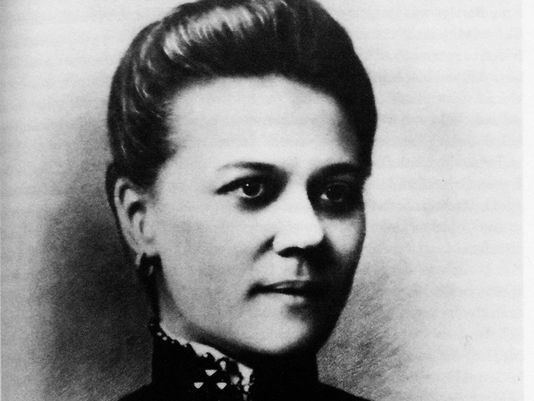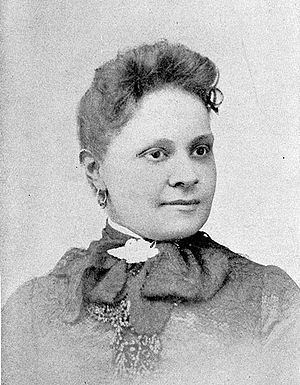Name Fannie Williams Role Educator | Books The new woman of color | |
 | ||
Died March 4, 1944, Brockport, New York, United States | ||
Fannie Barrier Williams, Intellectual Progress of the Colored Women of the US, Chicago, 1893
Frances "Fannie" Barrier Williams (February 12, 1855 – March 4, 1944) was an African-American educator and political and women's rights activist. She became well known for her efforts to have blacks officially represented on the Board of Control of the World's Columbian Exposition in 1893.
Contents
- Fannie Barrier Williams Intellectual Progress of the Colored Women of the US Chicago 1893
- Biography
- Social activism
- Columbian Exposition of 1893
- References

Biography
Frances (Fannie) Barrier was the youngest of three children born to Anthony and Harriet Barrier. Her father, born in Pennsylvania, came to Brockport, New York, as a child. He claimed to be partially of French descent. He worked as a barber and later became a coal dealer. Her mother Harriet was born in Sherburne, a small community in southeastern Chenango, New York, and the couple married in Brockport. The family attended the First Baptist Church in Brockport, and was the only black family in the congregation. Fannie recalled her Brockport youth as a time of innocence, but her personal experience and growing awareness of the unfair treatment received by women of color led her to pursue a lifetime of activism.
All three Barrier children attended Brockport public schools. After graduation, Fannie Barrier went on to the Brockport Normal School, a teachers college (now SUNY Brockport), and was the first African American to graduate in 1870. After graduation in 1875, Fannie Barrier went to the Washington D.C. area to teach, joining the emerging education movement, which focused on freedmen and freedwomen. She reported that she was "shattered" by the discrimination she encountered in the more southern city. She also experienced significant difficulties due to her race when she enrolled in the School of Fine Arts in Washington to study portrait painting, and had a similar experience when she attempted to study at the New England Conservatory of Music in Boston, Massachusetts.
While teaching in Washington, D.C., she met her future husband S. Laing Williams of Georgia. He worked in the United States Pension Office while studying law at Columbian University (later George Washington University Law School). They were married in Brockport in August 1887, returned to Washington, and eventually settled in Chicago, Illinois, where Williams was admitted to the Illinois Bar and began a successful law practice. The couple joined All Souls (Unitarian) Church in Chicago.
After the death of her husband in 1921, Barrier Williams remained in Chicago until 1926, when she returned to Brockport to live with her sister Ella D. Barrier. Barrier Williams continued to advocate for African-American women until her death in 1944.
Social activism
In Chicago, leaving behind her teaching career, Barrier Williams became active among local community activists and reformers. She was director of the art and music department of the Prudence Crandall Study Club, an organization formed by Chicago’s elite African-American community. With her husband, she worked for the Hyde Park Colored Voters Republican Club and the Taft Colored League.
Associating with both Frederick Douglass and Booker T. Washington, she represented the viewpoint of African Americans in the Illinois Women’s Alliance and lectured frequently on the need for all women, but especially black women, to have the vote. Her women’s rights was recognized when she was the only African American selected to eulogize Susan B. Anthony at the 1907 National American Woman Suffrage Association convention.
Barrier Williams was among the founders of the National Association for the Advancement of Colored People (NAACP). She also helped found the National League of Colored Women in 1893 and its successor, the National Association of Colored Women (NACW) in 1896. She was involved in the establishment and development of other reform- and service-oriented organizations, including:
When Barrier Williams was nominated as the first black woman to the prestigious Chicago Woman's Club in 1894, she and her supporters received threats, both public and private. It was a struggle to finalize her nomination, but she was finally inducted as a member in 1896. She was also the first black and the first woman on the Chicago Library Board.
Columbian Exposition of 1893
Barrier Williams achieved broader public recognition due to her efforts to gain representation of blacks at the Chicago Columbian Exposition of 1893. She succeeded in having two staff appointments designated for African-Americans and ensured that African-American interests were included in the program. She was appointed as Clerk in charge of Colored Interests in the Department of Publicity and Promotions.
Barrier Williams was invited to present two major addresses at the Exposition. In the first, "The Intellectual Progress of the Colored Women of the United States Since the Emancipation Proclamation", Barrier Williams addressed the World's Congress of Representative Women and disputed the notion that slavery had rendered African-American women incapable of the same moral and intellectual levels as other women. She called on all women to unite to claim their inalienable rights. Her address was followed by a discussion by Anna Julia Cooper and Fanny Jackson Coppin, as well as words of praise for all three women's speeches from Frederick Douglass.
The second speech was presented to the World’s Parliament of Religions. Entitled "What Can Religion Further Do to Advance the condition of the American Negro?", the address called upon churches, particularly those in the South, to open their doors to all people, regardless of race. Barrier Williams proclaimed a continuing belief in the ability of religion and faith to correct society’s problems.
